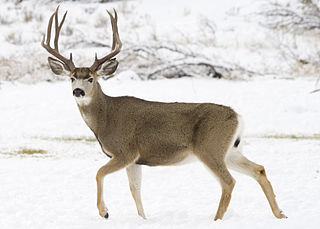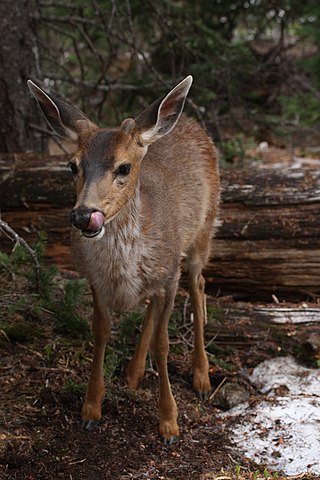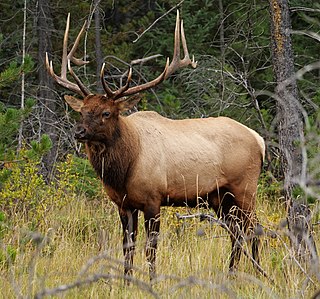
Chronic wasting disease (CWD), sometimes called zombie deer disease, is a transmissible spongiform encephalopathy (TSE) affecting deer. TSEs are a family of diseases thought to be caused by misfolded proteins called prions and include similar diseases such as BSE in cattle, Creutzfeldt-Jakob disease (CJD) in humans and scrapie in sheep. In the United States, CWD affects mule deer, white-tailed deer, red deer, sika deer, elk, caribou, and moose. Natural infection causing CWD affects members of the deer family. Experimental transmission of CWD to other species such as squirrel monkeys and genetically modified mice has been shown.

The white-tailed deer, also known as the whitetail or Virginia deer, is a medium-sized deer native to North America, Central America, and South America as far south as Peru and Bolivia, where it predominately inhabits high mountain terrains of the Andes. It has also been introduced to New Zealand, all the Greater Antilles in the Caribbean, and some countries in Europe, such as the Czech Republic, Finland, France, Germany, Romania and Serbia. In the Americas, it is the most widely distributed wild ungulate.

The mule deer is a deer indigenous to western North America; it is named for its ears, which are large like those of the mule. Two subspecies of mule deer are grouped into the black-tailed deer.

Two forms of black-tailed deer or blacktail deer that occupy coastal woodlands in the Pacific Northwest of North America are subspecies of the mule deer. They have sometimes been treated as a species, but virtually all recent authorities maintain they are subspecies.

Attwater Prairie Chicken National Wildlife Refuge is a federally protected refugium encompassing one of the largest remnants of coastal prairie habitat remaining in southeast Texas, United States, and home to one of the last populations of critically endangered Attwater's prairie chickens, a ground-dwelling grouse of the coastal prairie ecosystem.

The sambar is a large deer native to the Indian subcontinent, South China and Southeast Asia that is listed as a vulnerable species on the IUCN Red List since 2008. Populations have declined substantially due to severe hunting, local insurgency, and industrial exploitation of habitat.

The Key deer is an endangered deer that lives only in the Florida Keys. It is a subspecies of the white-tailed deer. It is the smallest extant North American deer species.
Parelaphostrongylus tenuis is a neurotropic nematode parasite common to white-tailed deer, Odocoileus virginianus, which causes damage to the central nervous system. Moose, elk, caribou, mule deer, and others are also susceptible to the parasite, but are aberrant hosts and are infected in neurological instead of meningeal tissue. The frequency of infection in these species increases dramatically when their ranges overlap high densities of white-tailed deer.

The Mexican wolf, also known as the lobo, is a subspecies of gray wolf native to southeastern Arizona and southern New Mexico in the United States, and northern Mexico; it also previously ranged into western Texas. It is the smallest of North America's gray wolves, and is similar to the Great Plains wolf, though it is distinguished by its smaller, narrower skull and its darker pelt, which is yellowish-gray and heavily clouded with black over the back and tail. Its ancestors were likely the first gray wolves to enter North America after the extinction of the Beringian wolf, as indicated by its southern range and basal physical and genetic characteristics.

In biology, culling is the process of segregating organisms from a group according to desired or undesired characteristics. In animal breeding, it is the process of removing or segregating animals from a breeding stock based on a specific trait. This is done to exaggerate desirable characteristics, or to remove undesirable characteristics by altering the genetic diversity of the population. For livestock and wildlife, culling often refers to the act of killing removed animals based on their individual characteristics, such as their sex or species membership, or as a means of preventing infectious disease transmission.

The Columbian white-tailed deer is one of the several subspecies of white-tailed deer in North America. It is a member of the Cervidae (deer) family, which includes mule deer, elk, moose, caribou, and the black-tailed deer that live nearby.

The Key Largo woodrat, a subspecies of the eastern woodrat, is a medium-sized rat found on less than 2,000 acres of the northern area of Key Largo, Florida, in the United States. It is currently on the United States Fish and Wildlife Service list of endangered species. Only 6500 animals were thought to remain in North Key Largo in the late 1980s.
Fern Cave National Wildlife Refuge is a 199-acre (0.8 km2) National Wildlife Refuge located in northeastern Alabama, near Paint Rock, Alabama in Jackson County.

The elk, or wapiti, is one of the largest species within the deer family, Cervidae, and one of the largest terrestrial mammals in its native range of North America and Central and East Asia. The word "elk" originally referred to the European variety of the moose, Alces alces, but was transferred to Cervus canadensis by North American colonists. The name "wapiti", derived from a Shawnee and Cree word meaning "white rump", is also used for C. canadensis.

The eastern cougar or eastern puma is a subspecies designation proposed in 1946 for cougar populations in eastern North America. The subspecies as described in 1946 was declared extinct by the U.S. Fish and Wildlife Service in 2011. However, the 1946 taxonomy is now in question. The Canadian Wildlife Service has taken no position on the taxonomy. Cougars are currently common in western North America and may be expanding their range. Individuals are occasionally seen as vagrants in eastern North America.
The Cedros Island mule deer is a subspecies of mule deer found only on Cedros Island off the coast of Baja California. Only about 50 individuals remain, with no captive population. Its behavior is similar to that of other subspecies of mule deer. The subspecies is threatened by feral dogs and poaching.

Cutaneous fibromas are common neoplasms occurring in wild and domestic deer of many species and are caused by host-specific viral infections. The fibromas occur most frequently in animals under 2 years of age, with cases in older deer reported occasionally or rarely.

Florida hosts many types of fauna. From coral reefs of the Florida Keys to the cypress swamps of the Panhandle, the state's diverse habitats are home to a variety of wildlife. Florida is among the top five states in terms of endemic species. There are over 700 terrestrial animals, 200 freshwater fish species, 1,000 marine fish and thousands of terrestrial insects and other invertebrates that inhabit the state. Florida's peninsular geography spans from subtropical to tropical zones, which, combined with its distinctive geology and climate, contribute to habitat diversity and an array of species. The native wildlife that exists in the state are of temperate and tropical origin.














